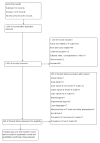Severity and mortality of severe Plasmodium ovale infection: A systematic review and meta-analysis
- PMID: 32559238
- PMCID: PMC7304606
- DOI: 10.1371/journal.pone.0235014
Severity and mortality of severe Plasmodium ovale infection: A systematic review and meta-analysis
Abstract
Plasmodium ovale can infect humans, causing malaria disease. We aimed to investigate the severity and mortality of severe P. ovale infection to increase the awareness of physicians regarding the prognosis of this severe disease and outcome-related deaths in countries in which this disease is endemic. Articles that were published in the PubMed, Scopus, and ISI Web of Science databases prior to January 5, 2020 and reported the prevalence of severe P. ovale infection were systematically searched and reviewed. Studies that mainly reported severe P. ovale infection according to the 2014 WHO criteria for the treatment of malaria were included. Two reviewers selected, identified, assessed, and extracted data from studies independently. The pooled prevalence of severe P. ovale mono-infections was estimated using the command "metaprop case population, random/fixed", which yielded the pooled estimate, 95% confidence interval (CI) and the I2 value, indicating the level of heterogeneity. Meta-analyses of the proportions were performed using a random-effects model to explore the different proportions of severity between patients with P. ovale and those with other Plasmodium species infections. Among the eight studies that were included and had a total of 1,365 ovale malaria cases, the pooled prevalence of severe P. ovale was 0.03 (95% CI = 0.03-0.05%, I2 = 54.4%). Jaundice (1.1%), severe anemia (0.88%), and pulmonary impairments (0.59%) were the most common severe complications found in patients infected with P. ovale. The meta-analysis demonstrated that a smaller proportion of patients with P. ovale than of patients with P. falciparum had severe infections (P-value = 0.01, OR = 0.36, 95% CI = 0.16-0.81, I2 = 72%). The mortality rate of severe P. ovale infections was 0.15% (2/1,365 cases). Although severe complications of P. ovale infections in patients are rare, it is very important to increase the awareness of physicians regarding the prognosis of severe P. ovale infections in patients, especially in a high-risk population.
Conflict of interest statement
The authors have declared that no competing interests exist.
Figures





References
-
- World Health Organization. Guidelines for the treatment of malaria. 3rd ed. Geneva: WHO; 2015.
-
- Stephens JWW. A new malaria parasite of man. Ann Trop Med Parasitol. 1922;16:383–8.
Publication types
MeSH terms
LinkOut - more resources
Full Text Sources
Medical

